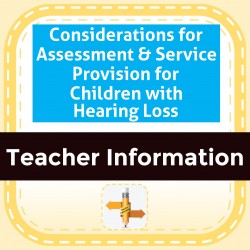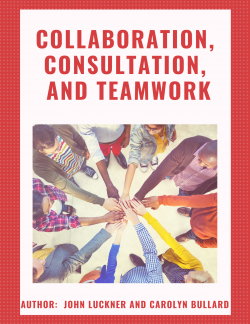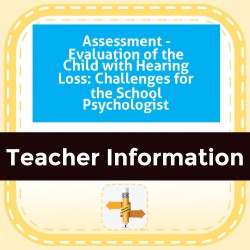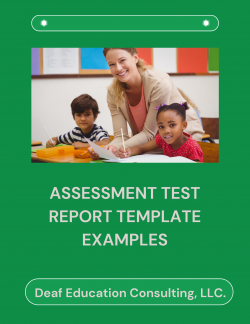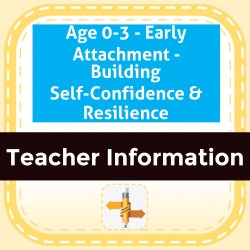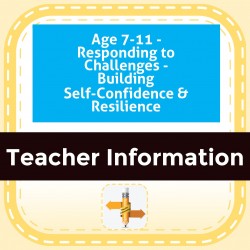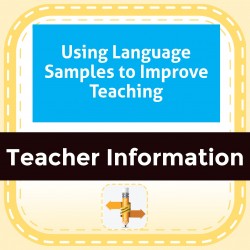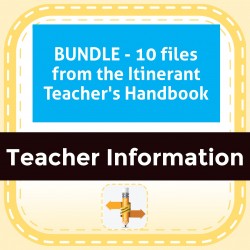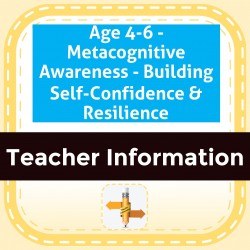Ability Levels
Categories
Resource Types
Age/Grade Range
CCSS
Anchor Standard
Speaking & Listening
Language
Reading
Considerations for Assessment & Service Provision for Children with Hearing Loss
$ 0
Informational handout provides a summary of access considerations, expanded core curriculum, assessments and providing skill building, support, and modified instruction as needed.
Collaboration, Consultation, and Teamwork
$ 395
This information describes the ways in which collaboration, consultation, and teamwork are essential skills for promoting students’ success. It includes factors that support collaboration, how to inf
...
nfluence others to make changes, how to be an effective team member, etc.
Assessment - Evaluation of the Child with Hearing Loss: Challenges for the School Psychologist
$ 0
Article describing challenges for the school psychologist in determining eligibility for counseling services.
Assessment Test Report Template Examples
$ 2
Have you ever wondered how to write up results in an assessment report? This resource provides examples of real results of functional and norm-referenced tests given to students who are deaf and hard
...
of hearing. This 21-page resource has examples you can use as a template, or even cut/paste into your own reports and change the data as appropriate. While it cannot be inclusive of ALL tests that may potentially given to students with hearing loss, there is a wide variety of great examples for many tests!
Age 0-3 - Early Attachment - Building Self-Confidence & Resilience
$ 250
For ages 0-3 years: This information addresses bonding and identification, initiation and early intervention, autonomy and supporting independence in putting on hearing devices. Includes teaching mate
...
rials for use by/with families. The purpose of this book is to raise awareness for the reasons why hearing device rejection happens and specific instruction to occur at different ages to build student resilience and self-confidence, thereby increasing the likelihood that they will not reject using their hearing technology. Specific teaching activities and recommendations for instructional materials to develop identified skills have been included in this Guide.
Age 7-11 - Responding to Challenges - Building Self-Confidence & Resilience
$ 250
For ages 7-11 years: This information addresses the components of resilience, building perseverance, goal setting, learning chunking skills, problem-solving, using humor, and reconciling feelings of f
...
itting in. The purpose of this book is to raise awareness for the reasons why hearing device rejection happens and specific instruction to occur at different ages to build student resilience and self-confidence, thereby increasing the likelihood that they will not reject using their hearing technology. Specific teaching activities and recommendations for instructional materials to develop identified skills have been included in this Guide.
Using Language Samples to Improve Teaching
$ 0
Standardized tests alone can miss vital language deficits in students who are DHH. This article uses current research to propose a common procedure for using language samples to assess and inform the
...
teaching of language for students with hearing loss.
Advocacy - Supplement to Steps to Success BUNDLE
$ 1095
This bundle of teacher information, worksheets, and activities include a range of advocacy topics from college preparation, to living indpendently. Students will acquire new vocabulary, use critical
...
thinking skills to solve problems, opportunities for self-discovery and discussion, and above all learn the who, what, when, how, and why of self-advocacy. Though some activities can be modified for upper elementary, most activities are for intermediate to advanced learners. 41 pages. Collected IDs in the BUNDLE: S0XHLU0740, S0XHLU0741, S0XHLU0742, S0XADV0743, S0XSOC0744, S0XSM0745, S0XADV0748.
BUNDLE - 10 files from the Itinerant Teacher's Handbook
$ 2595
This bundle includes 10 files from The Itinerant Teacher's Handbook: 1) Potential Impact of Hearing Loss, 2) Collaborative Relationships, 3) Life Balance, 4) Collaborative Teamwork, 5) Making Inclusio
...
n Work, 6) Promoting Language and Literacy, 7) Helping Parents Communicate, 8) Promoting Social Skills, Friendships, Self-Advocacy, 9) Assessment Issues, 10) Planning Transitions. Save 33% over purchasing all 10 separately. NOTE: Printed book is available for $59. P05TEA0426-435)
Age 4-6 - Metacognitive Awareness - Building Self-Confidence & Resilience
$ 6
For ages 4-6 years: This information addresses students recognizing that they have a hearing loss, understanding feelings, learning expected class listening behaviors, remembering what was heard via s
...
ubvocalization skills, responding to teasing, making friends. The purpose of this book is to raise awareness for the reasons why hearing device rejection happens and specific instruction to occur at different ages to build student resilience and self-confidence, thereby increasing the likelihood that they will not reject using their hearing technology. Specific teaching activities and recommendations for instructional materials to develop identified skills have been included in this Guide.
 Your browser is out of date. For best experience switch to latest updated Browser.
Your browser is out of date. For best experience switch to latest updated Browser.
 Get Chrome
Get Chrome Get Edge
Get Edge Get Firefox
Get Firefox